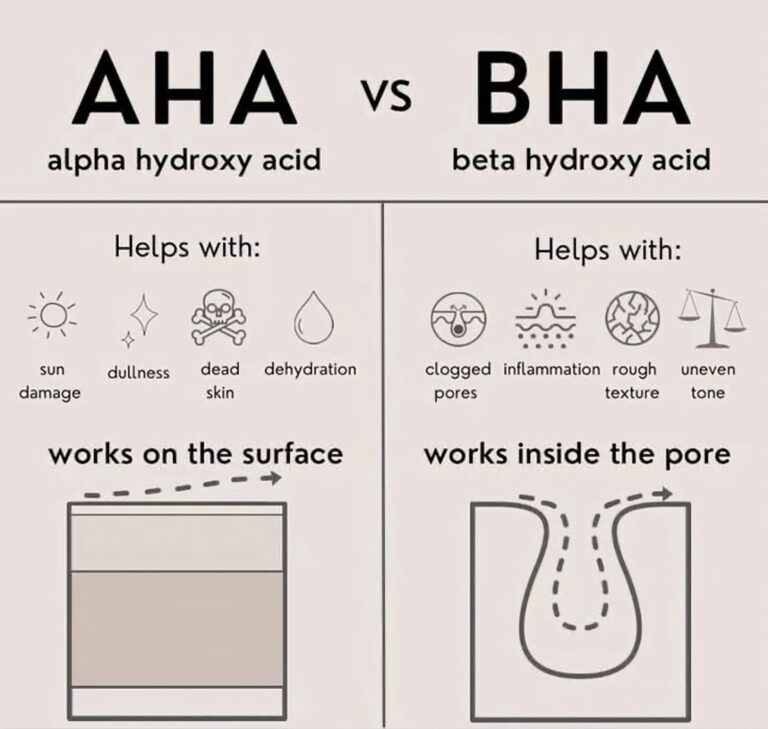
• paragraph comparing AHA (Alpha Hydroxy Acid) and BHA (Beta Hydroxy Acid):
Alpha Hydroxy Acid (AHA) and Beta Hydroxy Acid (BHA) are two types of hydroxy acids used in skincare products. While both exfoliate the skin, they differ in their source, exfoliation depth, and suitability for various skin types. AHA, derived from natural sources like fruits and milk, exfoliates the surface skin layers, hydrates, and brightens the skin, making it ideal for dry, sensitive skin. In contrast, BHA, derived from synthetic sources, penetrates deeper into pores, unclogging them and reducing acne, making it more effective for oily, acne-prone skin. AHA includes Glycolic Acid, Lactic Acid, and Malic Acid, whereas BHA is primarily Salicylic Acid. Understanding the differences between AHA and BHA helps choose the right product for specific skin concerns, such as acne, hyperpigmentation, or aging.
AHA (Alpha Hydroxy Acid) and BHA (Beta Hydroxy Acid) are both types of hydroxy acids commonly used in skincare products, particularly for exfoliation, brightening, and anti-aging purposes.

• AHA (Alpha Hydroxy Acid)
- Derived from natural sources like fruits, milk, or apples
- Water-soluble
- Exfoliates the skin’s surface
- Helps reduce the appearance of fine lines, wrinkles, and hyperpigmentation
- Suitable for dry, sensitive, or mature skin
- Common types:
- Glycolic acid (from sugarcane)
- Lactic acid (from milk)
- Malic acid (from apples)
- Tartaric acid (from grapes)
• BHA (Beta Hydroxy Acid)
- Derived from natural sources like wintergreen leaves or sweetgum trees
- Oil-soluble
- Penetrates pores to exfoliate and unclog
- Effective against acne, blackheads, and whiteheads
- Suitable for oily, combination, or acne-prone skin
- Common types:
- Salicylic acid (from wintergreen leaves)
Key differences:
- Solubility: AHA is water-soluble, while BHA is oil-soluble.
- Exfoliation: AHA exfoliates the skin’s surface, while BHA penetrates pores.
- Skin type: AHA is better for dry or sensitive skin, while BHA is better for oily or acne-prone skin.
Combining AHA and BHA:
- Using both can provide comprehensive exfoliation and skin benefits.
- Start with lower concentrations and gradually increase.
- Be cautious of potential irritation.
Remember, always patch test and consult with a dermatologist if unsure about using AHA or BHA products.

Benefits of AHA:
- Exfoliates the skin’s surface, removing dead skin cells.
- Hydrates the skin, improving texture and tone.
- Reduces appearance of fine lines, wrinkles, and hyperpigmentation.
- Stimulates collagen production, improving skin elasticity.
- Enhances skin brightness and radiance.
Benefits of BHA:
- Unclogs pores, reducing acne, blackheads, and whiteheads.
- Exfoliates within pores, preventing future clogs.
- Reduces inflammation and prevents future breakouts.
- Improves skin texture, reducing appearance of pores.
- Helps with skin discoloration and post-inflammatory hyperpigmentation (PIH).
Common AHA Products:
- Glycolic acid peels (5-30% concentration)
- Lactic acid serums (5-10% concentration)
- Malic acid toners (5-10% concentration)
- Moisturizers with AHA (2-5% concentration)
Common BHA Products:
- Salicylic acid cleansers (0.5-2% concentration)
- Spot treatments for acne (2-3% concentration)
- Exfoliating toners (0.5-2% concentration)
- Clay masks with BHA (0.5-2% concentration)
• Precautions and Side Effects:
AHA:
- Sun sensitivity: Use sunscreen with at least SPF 30.
- Irritation: Start with low concentrations, patch test.
- Dryness: Use hydrating products alongside AHA.
BHA:
- Irritation: Start with low concentrations, patch test.
- Dryness: Use hydrating products alongside BHA.
- Allergic reactions: Rare, but discontinue use if occurs.
Combining AHA and BHA:
- Start with lower concentrations (AHA 5%, BHA 0.5%).
- Gradually increase concentrations.
- Use AHA in the morning, BHA at night.
- Moisturize and use sunscreen.
Dermatologist Tips:
- Consult a dermatologist for personalized recommendations.
- Patch test new products.
- Start slow, increase frequency/concentration.
- Balance AHA/BHA with hydrating, soothing products.
AHA and BHA Benefits: - Improved skin texture
- Reduced appearance of fine lines and wrinkles
- Enhanced skin brightness
- Unclogged pores
- Reduced acne and inflammation
https://www.healthline.com/health/aha-vs-bha
AHA and BHA for Specific Skin Concerns:
- Acne: Salicylic Acid (BHA) more effective
- Hyperpigmentation: Glycolic Acid (AHA) and Lactic Acid (AHA)
- Rosacea: Gentle AHA products
- Eczema: Soothing AHA products
AHA and BHA Product Types:
- Toners
- Exfoliants
- Moisturizers
- Serums
- Masks
AHA and BHA Concentrations:
- Low (5-10%): Gentle, beginner-friendly
- Medium (10-20%): Effective for most skin types
- High (20-30%): Advanced, professional use
AHA and BHA Combination Products:
- Paula’s Choice 8% AHA + 2% BHA
- The Ordinary Glycolic Acid 7% + Salicylic Acid 2%
- Dermalogica Daily Microfoliant + Salicylic Acid
Natural Alternatives to AHA and BHA:
- Enzyme exfoliants (papain, bromelain)
- Fruit acids (citric, malic)
- Plant-derived AHAs (apple, grape)
Similarities: - Both exfoliate skin
- Improve skin texture and brightness
- Reduce appearance of fine lines and wrinkles
- Unclog pores
Differences:
AHA (Alpha Hydroxy Acid)
- Derived from natural sources (fruits, milk)
- Exfoliates surface skin layers
- Hydrates and brightens skin
- Suitable for dry, sensitive skin
- Examples: Glycolic Acid, Lactic Acid, Malic Acid
BHA (Beta Hydroxy Acid)
- Derived from synthetic sources
- Penetrates deeper into pores
- Unclogs pores, reduces acne
- Suitable for oily, acne-prone skin
- Example: Salicylic Acid
Key Differences:
- Exfoliation depth: AHA (surface), BHA (deep)
- Skin type: AHA (dry, sensitive), BHA (oily, acne-prone)
- Acne treatment: BHA more effective
- Hydration: AHA more hydrating
Comparison Chart:
| AHA | BHA | |
|---|---|---|
| Source | Natural | Synthetic |
| Exfoliation | Surface | Deep |
| Skin Type | Dry, Sensitive | Oily, Acne-prone |
| Acne Treatment | Less effective | More effective |
| Hydration | More hydrating | Less hydrating |


2 thoughts on “AHA VS BHA”